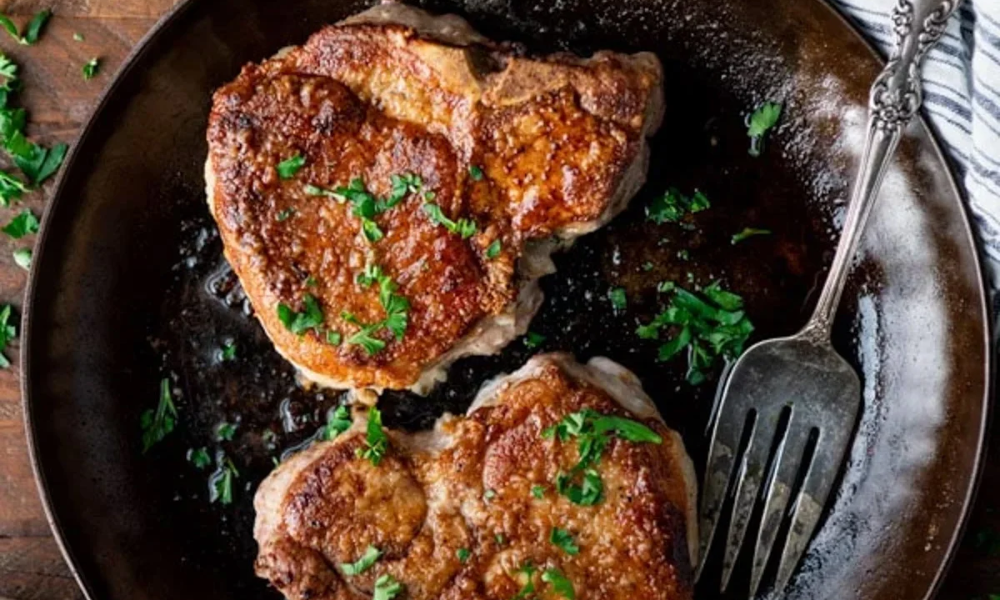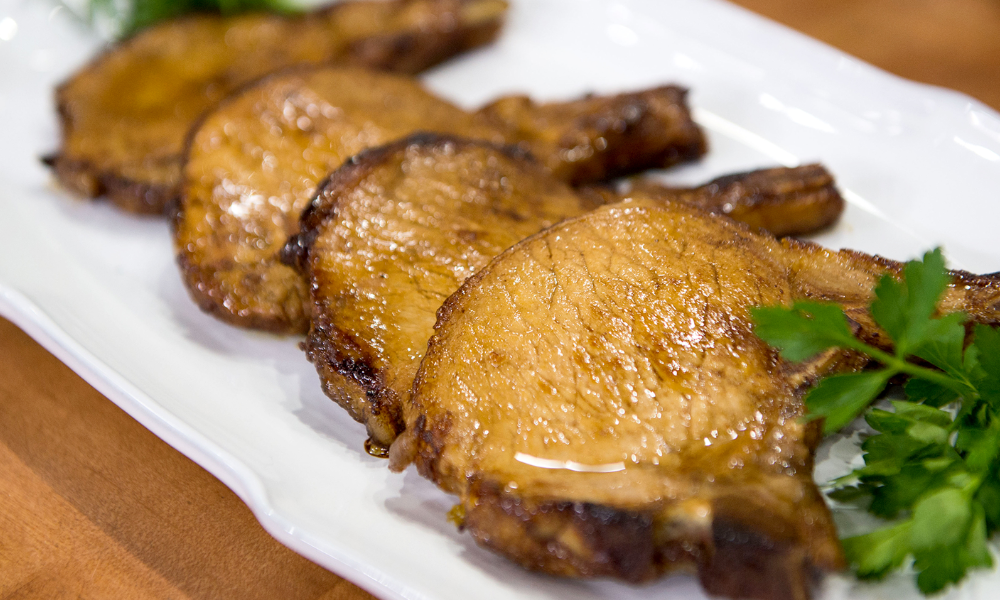Frying thin pork chops is a quick and simple way to make a tasty meal. You can get perfectly crispy and juicy pork chops every time if you use the right technique. This article will show you how to fry thin pork chops to perfection. We’ll advise you on choosing the best pork chops and the tools and ingredients you’ll need. Follow these simple steps, and you’ll be well on your way to a delicious and filling meal.
How to Fry Thin Pork Chops?
You’ve heard that bone-in pork chops are cheaper and easier to cook. These chops are also much more tender. Here’s how to cook them the right way. First, you’ll need a pan that can handle high heat. After that, place the pork chops in the pan and turn them over to cook on both sides. Once browned on one side, lower the heat a notch or two.
To fry thin pork chops, you will need the following:
- Thin pork chops (1/4-1/2 inch thick)
- Salt and pepper
- Flour
- Olive oil or vegetable oil
Here is a simple recipe for frying thin pork chops:
- Set your oven’s temperature to 350 °F (175 °C).
- Over medium-high heat, preheat a large skillet with one tablespoon of oil. Add salt and pepper to both sides of the pork chops.
- In a small dish, add some flour. Shake off any excess flour before dredging the pork chops.
- Pork chops should be added to the hot oil in the skillet. Until they are golden brown, cook for 2-3 minutes on each side.
- To cook the pork chops through, place the skillet in the preheated oven and bake for 8 to 10 minutes.
- Pork chops should rest for a few minutes after being removed from the oven and the skillet.
- Enjoy!
How to Select the Best Pork Chops?
When choosing pork chops, keep the following factors in mind:
Thickness: For frying, select pork chops 1/4-1/2 inches thick. Thinner chops will overcook and become tough, whereas thicker chops will take longer to cook and may be less tender.
Fat marbling: Pork chops with a small amount of fat marbling are more flavorful and tender than those with little or no fat marbling. However, keep an eye on your fat intake.
Cut: The center cut is the most common pork chop cut because it is leaner and more tender. Other cuts, such as rib chops and sirloin chops, may have more fat and flavor but may also be tougher.
Quality: Quality pork chops should be pale pink and have firm, white fat. Pork chops that are grey or have a sour odor should be avoided because they may be spoiled.
Sustainability: Consider purchasing pork chops from a local farmer or a farm that uses sustainable and humane farming methods. This can help your local community while ensuring that the pork you eat is high quality.
How Long does it Take to Cook Pork Chops in the Frying Pan?
The amount of time it takes to fry pork chops depends on their thickness and desired level of doneness. In a frying pan, thin pork chops (1/4-1/2 inch thick) will take about 2-3 minutes per side to cook.
The total cooking time for medium doneness (145°F/63°C) is approximately 8-10 minutes. The total cooking time for well-done pork chops is closer to 12-15 minutes.
Always use a meat thermometer to ensure your pork chops are cooked to the right temperature. Without touching the bone, insert the thermometer into the chop’s thickest area. Pork is considered to be cooked when the internal temperature reaches 145°F (63°C) for medium or 160°F (71°C) for well-doneness.
Allow the pork chops to rest for a few minutes before serving so the juices can redistribute. This will help the pork chops stay moist and tender. Enjoy!
Why are Bone-in Pork Chops Better?
Bone-in Pork Chops are More Economical
Bone-in pork chops tend to be more tender and juicier. This is due to the extra fat that the bone provides. They also take longer to cook. But there are some pros and cons to choosing bone-in over boneless. Bone-in chops are less common at your local supermarket, but most sell them.
Bone-in chops come in two basic varieties: rib chops and center-cut chops. Sirloin chops contain more bone than meat and are, therefore, tough unless you choose to cook them in a sauce.
They are more affordable than boneless chops. They are more convenient and look more professional when you choose to serve them. However, if you are looking for a fast weeknight meal, you may want to go with boneless pork chops. Bone-in pork chops also have more flavor as they release moisture while cooking.
Bone-in chops are also thicker, making them ideal for stuffing. Make sure to lay the thick bone-in chop on a cutting board and use a sharp knife to cut the chop along the bone. If there is a pocket in the meat, cut the pocket along the bone, keeping the sides intact.
How do you Make Pork More Tender?
Pork chops are often very lean and almost flavorless, so seasoning them well before cooking is important. Use dry herbs or favorite seasonings to add a nice zing to the chops.
A 30-minute dry brine is also a good way to improve the flavor and texture of the meat. Seasoning the chops several hours before they’re cooked will also help create a delicious crust on the pork chops.
Choose a hot pan to fry your chops in. It helps to sear the chops on both sides to get a nice crust on both sides. Be sure to cook your chops at medium heat – high heat can dry the meat and burn the inside. Medium heat will keep the outer edges tender, while the center will be just the right temperature.
If you’re planning on frying your chops, choose thin cuts. These cutlets will cook faster, which means less cooking time. Keep an eye on the temperature of the chops, as hot pork chops will dry out sooner than thick ones.
Do you Flip Pork Chops When Frying?
Flipping pork chops during cooking is necessary to guarantee even cooking on both sides. To ensure the pork chops are properly cooked, use a meat thermometer to check the internal temperature of the meat. Doing this can keep the pork chops from burning and ensure they cook to the right doneness.
To ensure that the pork chops are moist and tender, remember to let them rest for a few minutes before serving. This will allow the liquids to redistribute.
Why do My Pork Chops Become Tough When Fried?
Pork chops may become tough when fried for several reasons, including:
The pork chops may be overcooked. The proteins in the flesh might become rough and dry when cooking pork chops at a high temperature. Use a meat thermometer to check the pork chops’ internal temperatures.
The chops of pork can be too thick. Pork chops thicker than half an inch may take longer to cook, resulting in tougher meat. Choose pork chops for frying between 1/4 and 1/2 inch thick to prevent this.
The chops of pork can be too skinny. Chops of pork with little to no fat marbling might not be as tasty or tender as those with a little fat. Look for pork chops with minimal fat marbling to ensure juicy and tender chops.
Possible overheating during cooking. When frying pork chops, if the heat is too high, the outside of the meat may overcook and become rough before the middle is fully done. Use medium-high heat to prevent this, and flip the pork chops frequently to maintain even cooking.
There’s a chance the pork chops were frozen. Because the water in the meat expands as it freezes and damages the fibers, frozen pork chops may be more likely to become tough when cooked. Make sure your pork chops are properly defrosted before cooking to prevent this.
What Cooking Method is the Best for Pork Chops?
Pork chops can be cooked using various techniques, such as grilling, roasting, baking, and frying. Your preferences and the kind of pork chop you’re using will determine the best way to prepare them.
Grilling or roasting are fantastic options for producing juicy, tender pork chops. These techniques enable the fat in the pork chops to melt, giving the meat taste and moisture. The smokey flavor from grilling the pork chops is also a popular addition.
Another excellent method for preparing pork chops is baking, especially if you use thicker pieces. The slow cooking time provided by baking helps maintain the pork chops’ moistness and tenderness.
Pork chops can be cooked quickly and easily by frying, but the extra fat from the oil means that this approach may not be as healthful. However, this technique can still yield good results if you use high-quality oil and don’t over-fry pork chops.
In general, the ideal cooking technique for pork chops results in soft and moist meat. Try out various cooking techniques to determine which one suits you the best.
Conclusion
Thin pork chops are the most economical cut of pork. They can be used for a variety of cooking methods. For instance, they can be fried and then rested, making them a great choice for a quick meal. They also have more flavor.
Allow the pork chops to rest for a few minutes before serving to ensure they are moist and tender. This will also allow the juices to redistribute themselves throughout the pork chops.

